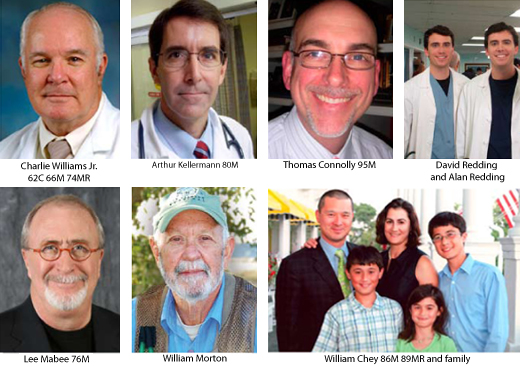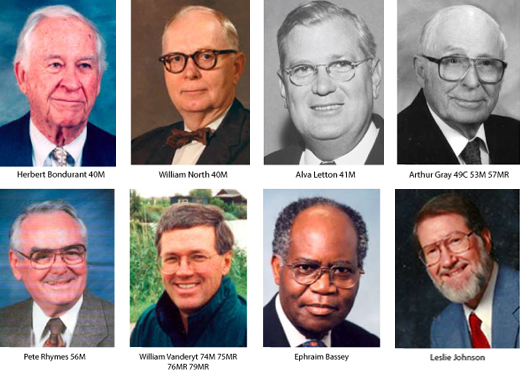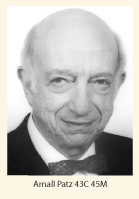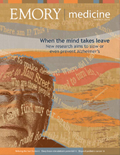Class Notes and Deaths

Please stay in touch by updating your contact information at http://alumni.emory.edu/updateinfo.php. If you would like to make a gift to honor a classmate, please contact the development office at 404-727-6917.
Alumni News
1960s
Charlie Williams Jr. 62C 66M 74MR of Daphne, Ala., was elected president of the medical staff of the VA Gulf Coast Health Care System.
1970s
Lee Mabee 76M received the 2009 Young at Heart Award from the South Dakota State Medical Association for inspiring young physicians as a role model and mentor and encouraging them to become involved in community projects.
1980s
Arthur Kellermann 80M, former associate dean for health policy in Emory’s medical school, recently started a new position with the RAND Corp. in Washington. He is spearheading its Public Heath Systems and Preparedness Initiative, helping state and federal agencies improve preparedness for public health emergencies. RAND is a not-for-profit that seeks to improve public and private policy.
He joined Emory’s faculty in 1993 as founding director of the Center for Injury Control (CIC), a collaborating center for injury and violence prevention of the World Health Organization.
Kellermann began studying gun-related violence as a resident at the University of Washington. The death of Motown singer Marvin Gaye provided the initial spark for Kellermann’s research. “I was sitting in the student center when the radio news show reported that Marvin Gaye had been shot by his father,” he said. “I looked at my friend across the table and said, `This is nuts. Surely somebody has looked at a gun in the home as a risk factor or a protection factor for violent death.’ ”
But he could only find one study on the subject. Later, his research showed that homicides occurred in homes with guns much more often than in homes without firearms, and family members were much more likely to be the victims rather than an intruder.
That research garnered him a lot of attention—and some of it unwelcome. A right-wing magazine at the time called Kellermann an “anti-gun fanatic” who was responsible for the anti-gun hysteria in America. Though he advocated keeping guns out of the home, he never called for an outright ban.
He went on to be the founding chair of the emergency medicine department at the medical school and later, the school’s first associate dean for health policy. He played a leading role in calling attention to health care policy in Georgia and in the United States. A member of the Institute of Medicine, Kellermann co-chaired its Committee on the Consequences of Uninsurance and played key roles in its efforts on the future of emergency care and national biosurveillance systems.
William Chey 86M 89MR, a gastroenterologist at the University of Michigan Health System, has been appointed incoming co-editor-in-chief of the American Journal of Gastroenterology.
1990s
Thomas Connolly 95M, of Jacksonville, Fla., was elected secretary-treasurer of the Northeast Florida Pediatric Society.
BORN: Auden Grace to Jennifer Burger 98M 99MR and husband Josh Greenbaum on April 2, 2010. She joins brother Alden. Jennifer is a dermatologist in Atlanta, and Josh is the director of data services for Emory’s development and alumni relations office.
2000s
Jeffrey Brewster 00M recently started a new position as a pediatric intermediate care physician at the Medical Center of Columbus Regional Healthcare System in Columbus, Ga.
BORN: Benjamin Hollis to Marguerite “Tresa” Allen-Chappell 98Ox 00C 04M and Clay Chappell 04M on Jan. 29, 2010. Tresa is a pediatrician in Alpharetta, Ga., and Clay is a cardiology fellow at Emory.
BORN: Jaya Marie to Arun Mohan 06B 07M and his wife, Carmen, on Dec. 16, 2009. Arun is in a primary medicine residency at Cambridge Hospital in Cambridge, Mass.
Residency Notes
Ilene Brennar (emergency medicine) recently authored How to Survive a Medical Malpractice Lawsuit.
Steven Bailey (ophthalmology) married Catherine Floyd on June 27, 2009. He is an assistant professor at the Casey Eye Institute of the Oregon Health & Science University.
William Morton (urology) recently released his book, The Story of Georgia’s Boundaries: A Meeting of History and Geography. The book received the Georgia Historical Society’s 2010 Lilla Hawes Award for the year’s best book on Georgia history.
David Redding (internal medicine) and his twin brother, Alan, opened a new practice in Atlanta, the Redding Allergy & Asthma Center.
Bhagwan Satiani (surgery) published his book, The Coming Shortage of Surgeons, in September 2009. He is a vascular surgeon at Ohio State University College of Medicine.
Deaths

1930s
James Stewart 38M of Glenwood, Ga., on Oct. 17, 2009. He was 96. He was past president of the American Society of Abdominal Surgeons and was a member of the American College of Surgeons, the Georgia Medical Association, and the Middle Georgia Medical Association. He is survived by a son, two grandchildren, and two great-grandchildren.
1940s
Herbert Bondurant Jr. 40M f Atlanta, on Aug. 22, 2009. He was 93. He was an orthopedic surgeon in private practice for 45 years and served as a clinical professor at Emory for many years. He is survived by his wife, Virginia, four children, and four great-grandchildren.
William North 40M of Mobile, Ala., on Jan. 20, 2010. He was 98. He served on the board of directors of Mobile General Hospital as it transitioned from a county hospital to USA Medical Center of the University of South Alabama. He is survived by his wife, Loraine, five children, and eight grandchildren.
Alva Letton 41M of Atlanta, on Jan. 13, 2010. A surgical oncologist, Letton was past president of the American Cancer Society (ACS). ACS credits him with being instrumental in getting the Pap smear accepted by women and their doctors back in the 1950s. In 1971, Letton stood beside President Richard Nixon as he signed the National Cancer Act, which established regional cancer centers. (In 1971, there were no centers; today there are more than 40.)
Letton continued to serve ACS as a volunteer and was the first volunteer to reach the 50-year mark. In 1991, he founded the Atlanta Cancer Center and was director of one of the first three breast cancer detection projects. He also served as director-secretary of the Southeastern Surgical Congress and as chair of public relations for the Fulton (County) Medical Society. He was a founder of the Georgia Biomedical Partnership and was appointed to the Georgia Science and Technology Committee and the Governor’s Science Advisory Board. He also served as a clinical professor of surgery at Medical College of Georgia. He is survived by his daughter and grandson.
Thomas McGowan 41C 43M of Philadelphia, on Feb. 5, 2007.
Martin Smith 41Ox 45M 49MR 50MR of Gainesville, Ga., on Jan. 18, 2010. He was a pediatrician in private practice for 30 years. He served a three-year term as chair of the Georgia chapter of the American Academy of Pediatrics and served as president of the national organization in 1985. During that time, he helped spearhead passage of the Vaccination Injury Compensation Act of 1986. He is survived by two daughters, six grandchildren, and three great-grandchildren.
Edwin Walker 44C 46M of South Bend, Ind., on April 5, 2009. He was 86. He is survived by his wife, Kathleen, and six children.
Marvin Dees 49M of Mansfield, Ohio, on March 12, 2010. He is survived by a daughter, son, grandson, and great-granddaughter.
1950s
Earnest Atkins Jr. 44C 51M 52MR 59MR of Alexandria, Va., on March 22, 2008. He was 85. He is survived by five children.
Joseph Benson 48C 52M of Wetumpka, Ala., on Dec. 18, 2009. He retired from his practice in 1990 after 40 years. He served on the Wetumpka City Council, the Elmore Community Hospital Board, and as the Elmore County coroner. He is survived by his wife, Peggy, four children, and two grandchildren.
Arthur Gray 49C 53M 57MR f Rome, Ga., on Jan. 3, 2010, following an extended illness. Gray served as chair of the surgical staff and president of the medical staff at both Floyd Medical Center and Redmond Regional Medical Center. When he began at the hospitals in 1958, there were no residents or emergency department doctors so Gray had to respond to all emergencies when he was on call. He later helped create the trauma center at Floyd Medical Center and served as medical director of Region 1 EMS (16 counties in northwest Georgia). He was appointed associate professor of family and community medicine at Mercer University. He is survived by his wife, Edith, three children, and 12 grandchildren.
Joe Bussey 50C 54M 55MR of Fort Worth, Texas, on Jan. 26, 2010. He was a founding partner of Ophthalmology Associates and retired in 1992. He also was a rancher for 47 years. He is survived by his wife, Anne, two children, and six grandchildren.
Carl Fromhagen 55M of Seminole, Fla., on Dec. 16, 2008. He was 82.
Pete Rhymes 56M of Santa Fe, N.M., in January 2010. He practiced orthopedic surgery in Mississippi, Texas, and Louisiana before retiring to Santa Fe in 2001. He is survived by his wife, Beverly, seven children, 10 grandchildren, and one great-grandson.
William Hardman 59M of Lake Wales, Fla., on April 6, 2010. He was an obstetrician and gynecologist for 51 years. He is survived by his wife, Mimi, and three children.
1960s
William Stone 45D 64M of Atlanta, on Feb. 7, 2010. He was 88. He practiced dentistry and medicine. He is survived by his wife, Charlene, three children, 14 grandchildren, and three great-grandchildren.
David Fetters 69M of San Francisco, on Oct. 28, 2009. He was 62. He was retired from the U.S. Navy after a career in nuclear medicine.
1970s
William Vanderyt 74M 75MR 76MR 79MR of Doraville, Ga., on Nov. 9, 2009, of brain cancer. He was 60 and an orthopedic surgeon. As an undergraduate student at Cornell University, he served as pacesetter for the school’s champion eight-man crew team. In 2009, one year into retirement, he decided to take up rowing again. In January, he began working out at home on a rowing machine. By June he competed in three events at the Southeast Regional Championship Regatta in Aiken, S.C. His team won two gold medals and one silver. He is survived by his wife, three children, and two grandchildren.
1980s
James Hazlehurst 82M of Chico, Calif., on Nov. 5, 2009, of brain cancer. He served in the Navy for 12 years, including the first Gulf War in 1990, as an ophthalmologist and flight surgeon. After his service, he opened the Chico Eye Center. He retired in January 2005 after learning he had a malignant brain tumor. He is survived by his wife, Janice, and three sons.
1990s
James Clark 91M of Hoboken, Ga. Unknown date of death.
Residency Deaths
James Anthony (surgery) of Stone Mountain, Ga., on Aug. 16, 2009. He served as chief of surgery at DeKalb General Hospital, was president of the DeKalb Medical Society, and served on the board of medical examiners. He is survived by his wife, Helen, and five children.
Ephraim Bassey (nephrology) of Mableton, Ga., on Aug. 24, 2009. He was born in Nigeria and worked as a pharmacist in Lagos before graduating magna cum laude from medical school at the University of Bonn, Germany. He founded Atlanta South Nephrology and served as medical director for three dialysis clinics. He is survived by his wife, Patricia, and four daughters.
Thomas Boswell (internal medicine) of Ball Ground, Ga., on Nov. 28, 2007. He was 85. He served rural communities in three north Georgia counties. He is survived by his wife, Jean, a son, three daughters, and 12 grandchildren.
John Cheatham (ophthalmology) of Rancho Santa Fe, Calif., on Nov. 2, 2009. He was 68 and suffered a heart attack while climbing Kennesaw Mountain in Georgia. Beyond his residency at Emory, he never practiced ophthalmology in the United States. Shortly after his residency, he moved abroad to work in developing countries. He never owned a home, a car, or cell phone. His possessions consisted only of a closet of items that he stored at his mother’s home in Atlanta.
Cheatham’s journey to medical school also took a different path. After graduating from Georgetown University, he earned a commercial pilot’s license and then worked as a bush pilot in Africa, New Guinea, and near the Amazon rainforest. He and his sister made a 2,500-mile trip down the Amazon River in a dugout canoe.
He returned to the United States and earned an MBA degree from Columbia University. During his late 30s, he realized he wanted to be a doctor, though at the time, medical schools considered him to be too old to be admitted. He spent a decade trying to get into medical school. He bought medical books and taught himself. He passed Part 1 of the national medical boards before he enrolled in medical school.
He was finally admitted to the Medical College of Georgia and was able to bypass all premed courses.
During recent years, he had climbed Mount Kilimanjaro and made 50-mile hikes in the Grand Canyon.
In June 2009, he married his longtime partner and coworker, Anne Schlueter.
He is survived by her, his mother, a sister, and two brothers.
Max Clayton (anesthesiology) of Tucson, Ariz., on May 12, 2009. He was 76.
Leslie Johnson (radiology) of Burlington, N.C., on Aug. 18, 2009, of Alzheimer’s disease. He is survived by his wife, Barbara, and daughter.
Richard Johnson Sr. (internal medicine) of Atlanta, on Jan. 18, 2010. He practiced at Piedmont Hospital for 40 years, during which he served as chief of the medical staff from 1986 to 1988. After retiring in 1993, he served for 16 years as a consultant for the disability determination service of the Social Security Administration. He is survived by his wife, Nancy, eight children, 15 grandchildren, and seven great-grandchildren.
Norman Lavy (hematology) of Westfield, N.J., on Oct. 7, 2009. He was 78. He was a professor of medicine at Robert Wood Johnson University Medical Center. From 1966 to 1987, he was vice president and director of drug regulatory affairs at E.R. Squibb & Sons. He is survived by his wife.
Howard Liss (pulmonology) of Jerusalem, in 2007. He worked at Hadassah University Hospital, the largest health care system in Israel. He was on faculty at Wright State University from 1985 until at least 1990. He is survived by a daughter.
Daniel Mahaffey (surgery) of Louisville, Ky., on Jan. 25, 2010. He was 84. He was part of the team that performed the first open heart surgery in Louisville. The team spent a year preparing with dogs, and Mahaffey personally purchased a heart-lung machine for the surgery in 1960. He is survived by his three daughters and two grandchildren.
Edward Parrish III (internal medicine) of Atlanta, on Sept. 21, 2009. He was 55. He is survived by his wife, Gloria, six children, and three grandchildren.
Hugh Sealy Jr. (medicine) of Macon, Ga., on Oct. 21, 2009. He was 84. He is survived by his wife, Connie Sue, and four children.Stewart Smith (pediatrics) of Chattanooga, Tenn., on Oct. 26, 2009.
Stewart Smith (pediatrics) of Chattanooga, Tenn., on Oct. 26, 2009.
Donald Sondag (obstetrics/gynecology) of Winter Park, Fla., on May 13, 2008. He was 77.
Terrence Yoder (pediatrics) of Atlanta, on Sept. 12, 2009. He was 45. He is survived by his son, parents, and two sisters.

John E. Skandalakis 62G, a faculty member for more than 30 years, died of leukemia on Aug. 29, 2009. He was 89. “Dr. Skan,” as he was known to his colleagues and medical students, taught surgical anatomy.
Born in 1920 in Sparta, Greece, Skandalakis earned his medical degree from the University of Athens in 1946. He fought in the Greek resistance during WWII and hid two Jews under the altar of his neighborhood church. After WWII, he fought in the Greek Civil War (his older brother was killed, his remains found decades later) before immigrating to the United States in 1951. He completed his residency and fellowship at Grady Hospital, St. Joseph’s Infirmary, and Piedmont Hospital.
In 1956 he began working jointly as an instructor in anatomy at Emory—receiving his doctorate in anatomy from Emory in 1962—and at Piedmont as director of surgical education, a program he initiated that allowed Emory surgical residents to rotate through the hospital.
Skandalakis founded the Thalia and Michael Carlos Center for Surgical Anatomy and Technique at Emory in 1984 and the Alfred A. Davis Research Center for Surgical Anatomy and Technique in 1990, serving as director of both until his death. In 1996, the John E. Skandalakis Professor of Surgery Chair was established in his honor at the School of Medicine.
Among his 300 publications were three highly regarded books, Embryology for Surgeons, Anatomical Complications in General Surgery, and Surgical Anatomy and Technique: A Pocket Manual, which have been translated into numerous languages and are still referenced. He was a fellow of the American College of Surgeons, a founding member of the American Association of Clinical Anatomists, and a member of the Georgia Board of Regents from 1981 to 1988, during which he was instrumental in the founding of the Georgia State University’s law school. He was honored with membership in the prestigious Academy of Athens in 1992 and received the Distinguished Medical Achievement Award from the School of Medicine in 1999. In his later years, Skandalakis was an international lecturer on anatomy.
|
||
Arnall Patz Lifetime Achievement AwardIn 2007, the School of Medicine inaugurated a lifetime achievement award in Patz’s honor. The recipients of the Arnall Patz Lifetime Achievement Award are selected by committee for their accomplishments in medicine, significant contributions to medical research, or exceptional commitment and dedication to the medical school. The award is given each fall during alumni weekend. The 2008 recipient was John Inman 45M, and David E. Clapham 79G 81M received the 2009 award. |
||

 Death of a groundbreaking Emory doctor
Death of a groundbreaking Emory doctor